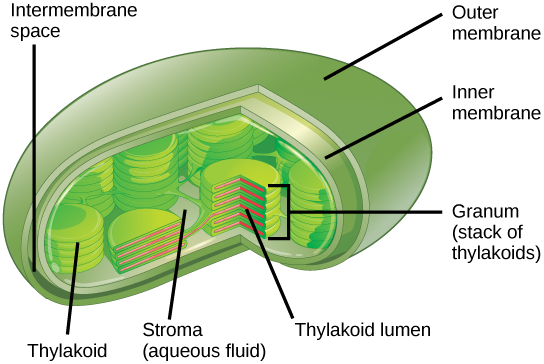
Draw the structure of chloroplast and label the parts.
Answer
483.3k+ views
Hint: Chloroplasts are membrane bound plastids that contain a network of membranes embedded into liquid matrix and contain chlorophyll which imparts green color to plants and helps in photosynthesis.
Complete answer:

Following are the parts of chloroplast:
1) Envelope or outer membrane- semi-porous in nature and permeable to small molecules and ions but it is not permeable to larger proteins.
2) Intermembrane space- it is a thin space of 10-20 nanometers which is present between the outer and inner membrane of chloroplast.
3) Inner membrane- it forms a border to the stroma. It helps in regulating the passage of materials in and out as well as regulates the fatty acids and lipids also synthesized in this membrane.
4) Stroma- it is an alkaline, aqueous fluid which is present within the inner membrane of the chloroplast. Space outside the thylakoid space is known as stroma.
5) Thylakoid system- it is suspended in the stroma. This system is a collection of membranous sacs known as thylakoids. They are arranged in stacks called grana. Each granum contains 10-20 thylakoids.
6) Peripheral reticulum- chloroplasts of some plants contain an additional set of membranous tubules known as peripheral reticulum which originates from the inner membrane. Tiny vesicles bud off from the inner membrane and form the tubules of the peripheral reticulum.
Note: All of the components of chloroplast participate in several functions of the cell. Chloroplasts also provide metabolic activities for plant cells.Chloroplasts are biconvex or plano convex in shape. It has different shapes like spheroid, filamentous, ovoid.
Complete answer:

Following are the parts of chloroplast:
1) Envelope or outer membrane- semi-porous in nature and permeable to small molecules and ions but it is not permeable to larger proteins.
2) Intermembrane space- it is a thin space of 10-20 nanometers which is present between the outer and inner membrane of chloroplast.
3) Inner membrane- it forms a border to the stroma. It helps in regulating the passage of materials in and out as well as regulates the fatty acids and lipids also synthesized in this membrane.
4) Stroma- it is an alkaline, aqueous fluid which is present within the inner membrane of the chloroplast. Space outside the thylakoid space is known as stroma.
5) Thylakoid system- it is suspended in the stroma. This system is a collection of membranous sacs known as thylakoids. They are arranged in stacks called grana. Each granum contains 10-20 thylakoids.
6) Peripheral reticulum- chloroplasts of some plants contain an additional set of membranous tubules known as peripheral reticulum which originates from the inner membrane. Tiny vesicles bud off from the inner membrane and form the tubules of the peripheral reticulum.
Note: All of the components of chloroplast participate in several functions of the cell. Chloroplasts also provide metabolic activities for plant cells.Chloroplasts are biconvex or plano convex in shape. It has different shapes like spheroid, filamentous, ovoid.
Recently Updated Pages
Master Class 11 Economics: Engaging Questions & Answers for Success

Master Class 11 Business Studies: Engaging Questions & Answers for Success

Master Class 11 Accountancy: Engaging Questions & Answers for Success

Master Class 11 English: Engaging Questions & Answers for Success

Master Class 11 Computer Science: Engaging Questions & Answers for Success

Master Class 11 Maths: Engaging Questions & Answers for Success

Trending doubts
State and prove Bernoullis theorem class 11 physics CBSE

What are Quantum numbers Explain the quantum number class 11 chemistry CBSE

Write the differences between monocot plants and dicot class 11 biology CBSE

Why is steel more elastic than rubber class 11 physics CBSE

Explain why a There is no atmosphere on the moon b class 11 physics CBSE

1 ton equals to A 100 kg B 1000 kg C 10 kg D 10000 class 11 physics CBSE




